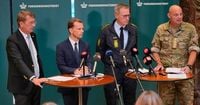For the second time in as many nights, Danish airports found themselves at the center of an unnerving security crisis this week as a wave of unexplained drone overflights forced closures, flight cancellations, and heightened worries about foreign interference. Authorities in Denmark, a nation perched at the crossroads of Northern Europe’s busiest shipping and air corridors, now say the pattern of incidents points to a deliberate, professional, and potentially hostile campaign targeting critical infrastructure.
The disruptions began on the night of September 22 to 23, 2025, when Copenhagen Airport—the largest in Scandinavia—was forced to suspend operations for several hours due to unidentified drones in the vicinity. According to ABC News, similar chaos struck Oslo Airport in Norway that same evening, with both capitals lying along the vital Skagerrak and Kattegat straits. The situation escalated further on September 24 and 25, when Aalborg Airport, which serves both civilian and military flights on the northern tip of Zealand island, was completely closed after drones were spotted overhead. Flights were grounded until after midnight, and a KLM flight from Amsterdam was forced to turn back, while a Scandinavian Airlines service from Copenhagen was cancelled, as reported by MGDK.
But the threat didn’t stop there. Drones were also reported over the southern Danish cities of Esbjerg and Sønderborg, as well as the Fighter Wing Skrydstrup air base—home to the country’s F-16 fighter jets. The Danish National Police confirmed the systematic nature of the drone activity, with incidents occurring at multiple sensitive locations nearly simultaneously. The lights on the drones were reportedly switched on during their flights, making them visible to both authorities and civilians, but police decided against attempting to shoot them down, citing safety concerns.
Denmark’s Defense Minister, Troels Lund Poulsen, addressed the nation in a Thursday morning press conference, describing the episodes as a “hybrid attack using different types of drones.” He emphasized, “There can be no doubt that everything points to this being the work of a professional actor when we are talking about such a systematic operation in so many locations at virtually the same time.” The term “hybrid attack” is typically reserved for coordinated efforts that blend physical, technological, and psychological elements to destabilize a target—without open military confrontation.
Prime Minister Mette Frederiksen echoed these concerns, labeling the initial drone intrusions as “a serious attack against critical infrastructure in Denmark.” While she stopped short of directly blaming any specific country, Frederiksen stated, “I cannot reject in any way that it could be Russia.” She added that “there is mainly one country that poses a threat to European security,” a sentiment reflecting broader regional anxieties. The Danish Security Intelligence Service further assessed that the incidents resembled “a model of hybrid warfare we have seen elsewhere in Europe,” and warned that the risk of Russian espionage and sabotage in Denmark remains high.
These suspicions are not without precedent. Recent months have seen a string of drone and fighter jet intrusions into Polish, Romanian, and Estonian airspace—events widely attributed to Russian military maneuvers. In Denmark, the investigation quickly expanded to consider whether the drones might have been launched from nearby ships. According to Ekstra Bladet, a Russian warship, the Aleksandr Shabalin, was spotted off Denmark’s coast with its transponder turned off in the days leading up to the incidents. Danish authorities also identified three tankers with links to Russia—the Astrol 1, Pushpa, and Oslo Carrier 3—as possible launch points. Of these, only the Pushpa was confirmed to be near Aalborg on the night of September 24 to 25. The Pushpa, also known as Boracay, is listed by Ukraine as part of Russia’s so-called “shadow fleet”—vessels often uninsured and used to evade sanctions, sailing under the flag of Benin.
Yet, despite these leads, Danish officials remain cautious about drawing firm conclusions. “We have no evidence to make the direct link to Russia,” Poulsen told reporters, even as the Danish Security Intelligence Service and other agencies continue to probe all possible origins. Police Chief Superintendent Jens Jespersen noted that authorities are investigating several theories, including the possibility of drone launches from international vessels. Commissioner Thorkild Fogde added, “It is my impression that the investigation is well-informed when it comes to international vessels... The warship is included as one of the leads in the investigation.”
The Russian government, for its part, has flatly denied any involvement. Kremlin spokesperson Dmitry Peskov dismissed the Danish statements as “baseless accusations,” while the Russian embassy in Denmark called the drone sightings “a staged provocation.” In a post on Telegram, the embassy wrote, “Undoubtedly, they will be used as a pretext for further escalating tension in the interests of forces seeking by all means to prolong the Ukrainian conflict and extend it to other countries.”
Meanwhile, the Danish government is moving swiftly to bolster its defenses. Minister of Justice Peter Hummelgaard announced plans to “acquire new capabilities for detection” and to present legislation that would “provide increased opportunities for infrastructure owners to also shoot down drones.” Authorities say the goal of these flyovers is clear: to sow fear and division. “The goal of this kind of hybrid attack is to create fear,” Hummelgaard said, “It is to create discord and it is to make us afraid.”
International support has also been forthcoming. French President Emmanuel Macron pledged assistance in safeguarding Danish airspace, and NATO Secretary-General Mark Rutte confirmed that the alliance is working closely with Denmark. “NATO allies and Denmark are working together on how we can ensure the safety and security of our critical infrastructure,” Rutte posted on X, formerly Twitter.
For now, the skies over Denmark remain uneasy. Flights have resumed, but the specter of further disruptions—and the broader implications for European security—linger. As authorities continue their investigation, Denmark’s experience serves as a stark reminder of the new face of conflict in the 21st century: silent, shadowy, and often airborne.


